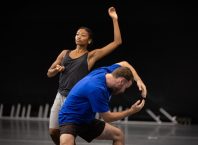Dancer, choreographer, word-weaver, a versatile actor who can embody any role, Hillel Kogan can do just about anything and everything, and he does. In his outrageously entertaining solo work “Everything” Kogan recreates and deconstructs 60 years of Israeli history, kinetic social criticism in white glitter. “Everything” will be performed this coming Thursday, August 20th at the Tmuna Theatre, as part of a joint evening with Yossi Berg and Oded Graf. In an early morning conversation over coffee and croissants, Kogan reflected on the work and its relationship to Israeli culture.
“I wanted to create a piece for 60 years to the State of Israel and took that as my inspiration. I began to think of all sorts of images but I saw that most of them were actually negative. Israeli is pushing in the supermarket, pushing your nose into someone else’s business, stuffing yourself with food, being a fanatic, feeling that you are better than everyone else, that you are special, chosen. The more I asked myself these questions I saw that there is an image of the ugly Israeli, a familiar cliché we see on television and laugh at in parodies and satires. I decided to dedicate the main character to this image,” he says with a slightly mischievous delicate smile.
“I thought of a process of reverse evolution – from culture to bestiality, which is the story of this character, and in parallel, also, I feel, of our society which began with a pure sort of idealism and today we see a lack of tolerance for minorities, lack of unity, a lack of values. It’s a bleak picture and I know reality is not black and white, but I wanted to bring that criticism to the stage.”
Kogan brings a level of quality and aesthetic appeal to the work informed by his training at Bat Dor and years of dance experience. After two years as a dancer in the Geneva based company Nomad, Kogan was with the Gulbenkian Dance Company in Portugal for seven years, until its abrupt closure by the foundation. Fully intending his work to be appealing and entertaining, Kogan delivers a subtle and subversive critique of contemporary Israeli culture. He describes the character he created as “someone very charming, it’s a show. He’s in white, a little like the host on a TV show. There is something inviting and inspiring admiration about him, but he is false and corrupt, like politicians who tell stories of what they will build but out of the goodness of their hearts, rather from a desire for power and attention.”
Of Israel and Israelis he says, “We see ourselves as a very moral society but the rest of the world doesn’t view us that way at all – which is a kind of indicator. This is our self-image – that of a moral society – this is how we like to think of ourselves, but our behavior is not like that. We do not behave like a chosen people.” In its lively, humorous presentation the dance piece presents the audience with a character they can view from a certain distance and therefore accept. One might imagine it as a provocative starting point for discussion in history and citizenship classes in high schools.
In addition to performances of “Everything”, Kogan is rehearsal director for the junior company of the Bat Sheva Dance Company, working as a dancer in a new production of Yossi Berg and Oded Graf, and is already creating a new choreographic work of his own. “I am thinking about the pursuit of happiness,” he says, “of course, from a cynical perspective of the Jewish obsession: you have to be happy. I am thinking of the hedonistic search for pleasure in which you are unaware of your own pain and unwilling to acknowledge or confront existential suffering.”
In some sense, this new work continues the line of thought in “Everything” as Kogan continues to reflect on Israeli culture. “The more difficult our daily lives, the more we seek pleasure,” he says, while delicately consuming an almond croissant, “I think that Tel Aviv with its night life and flourishing culture is an effect of that difficulty.” Referring to the recent surge of violence in the city, Kogan adds, “It’s not random that our newspapers are full of reports of violence, we have a very difficult political life and we try to create a balance by over-indulging in discotheques and parties.”
“There is a great dichotomy between our daily lives and our night life. In the clubs people forget reality. When there was a war going on, people in Tel Aviv continued to go to coffee houses and discotheques as usual. We are not aware of what is happening in other cities…of what is happening around us.”
Kogan returned to Israel in 2005 after almost a decade in Europe, saying that when he first returned, it was a shock – but a good one. Kogan explains that when he left Israel in 1996 to pursue his dance career abroad, “I left with a lot of negative feelings and criticism. I felt that there is a constant fight for survival here. Dancers and choreographers are not appreciated, and there is no funding for dance and no possibility to develop. When I returned, I found a completely different scene. The country had changed and for the first year I was euphoric. It is so colorful here and there is so much to do – I felt what tourists feel about the country: that it is so warm, there is so much variety.”
In terms of dance Kogan was attracted to the work of Merce Cunningham from an early age, saying, “He is my master in dance and art.” He studied with Cunningham and occasionally conducts workshops in the method. Yet Kogan enjoys the diversity of the Israeli scene where dancers come from different backgrounds in terms of their training and approach. According to Kogan, “The dance here demands creativity from the dancer within the process; he is not a tool who is only required to perform on a technical level. That approach creates mediocre dancers who view dance as a sport involving only the body, without a spiritual experience. I am not moved by seeing a “beautiful body” on the stage, in the classical sense of ballet. It moves me to see people onstage, people of all colors and ages. I don’t believe that dancers need to retire at age 40. Even in sports it could be interesting to see a soccer game played by players who are over 60. I plan to dance forever.”
Performances:
Thursday, August 20 at 20:30
Tmuna Theatre 8 Soncino Street Tel Aviv
Tickets: 03-5629462






Comments are closed.